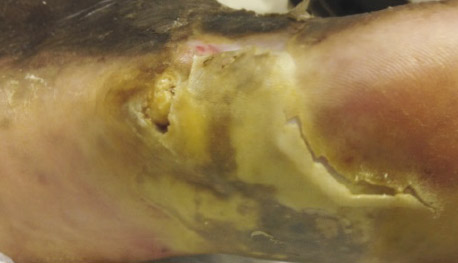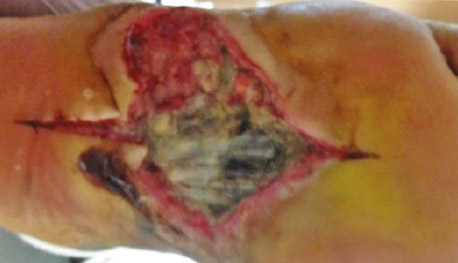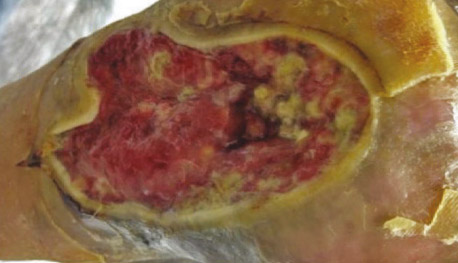Case study: Diabetic neuropathic ulcer
Wound type:
Diabetic ulcer
Patient
56-year-old African American
History
Non-compliant, uncontrolled diabetic
Complete closure of the wound after enzymatic debridement with SANTYL◊ Ointment for 61 days followed by approximately 109 days of REGRANEX◊ gel*
*Individual results will vary
Wound presentation
- The patient presented with a full-thickness wound covering approximately 50% of the plantar surface of the right foot
- The wound consisted of extensive, oozing necrotic tissue, surrounded by edema and the presence of macerated slough
- An observational diagnosis of necrotizing fasciitis was made (and later confirmed by lab results)
- No other symptoms related to the wound were reported by the patient and no prior wound care had been performed on the foot by the patient or any health care professional
Treatment
- The unroofing of necrotic tissue was performed in the physician’s office
- The patient was immediately admitted to the hospital via the emergency room for further intervention
- Treatment included: initiating IV antibiotics, performing a wide excisional debridement in the operating room and a bedside sharp debridement
- SANTYL Ointment was initiated for enzymatic debridement for a period of time, followed by REGRANEX gel
- The patient had ongoing office visits and sharp debridements in the form of paring of the wound edges, throughout the case. The patient was also referred to an endocrinologist for glycemic control
- The patient was compliant with all home wound care and maintaining controlled glycemic levels
Day 1-4
- Wound unroofed in physician’s office
- Remaining white area surrounding necrotic tissue is edema
- Macerated slough present Immediate admittance to hospital via emergency room
- Placed on IV antibiotics, glycemic control implemented
- Wide excisional debridement performed in operating room
- Subsequent bedside debridement performed
- Subcutaneous air in the plantar present confirming necrotizing fasciitis
- Blood glucose level confirmed polymicrobial dominant strain
Day 4
- Post-wide excisional and bedside debridements
- Wound measures 12.0cm x 10.0cm
- Daily application of SANTYL Ointment initiated
- Discharged from hospital on day 10
- Instructed to maintain glycemic control
- Home wound care and offloading continued
Day 28
- First office visit approximately three weeks after hospital discharge; wound measurements not taken, appeared unchanged
- 40% reduction in slough, no edema present
- Granulation tissue replacing necrotic tissue
- Edges pared
- Daily application of SANTYL Ointment continued
- Home wound care and offloading continued
Result
Complete closure of the wound after enzymatic debridement with SANTYL◊ Ointment for 61 days followed by approximately 109 days of REGRANEX◊ gel*
*Individual results will vary
Download patient case study: Diabetic neuropathic ulcer




